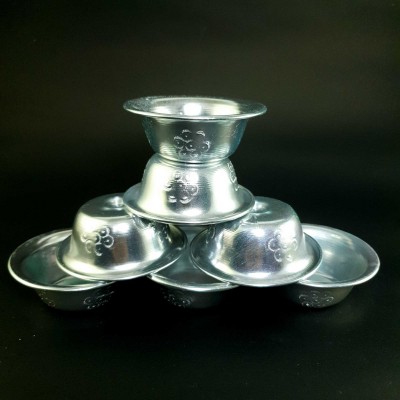Loading Content..

The most common type of offering on Tibetan Buddhist shrines are made with seven water offering bowls â called âyonchapâ in Tibetan.
The main point of any offerings is a pure motivation to cultivate generosity and to reduce our selfishness, stinginess, and greed.
We seek to give with an open, pure heart, with no attachment to what we are giving, and with no motivation of receiving something in return.
The main point of any offerings is a pure motivation to cultivate generosity and to reduce our selfishness, stinginess, and greed.
We seek to give with an open, pure heart, with no attachment to what we are giving, and with no motivation of receiving something in return.
Paradoxically, as His Holiness the Dalai Lama often teaches, cultivating generosity and devoting ourselves to the welfare of others increases our own happiness in many ways, as we release the painful, stiff worry that accompanies greed and self-centeredness.
He encourages us to become selfishly altruistic, to become happy people by concerning ourselves primarily with the well being of others.
One reason that we offer water is that water in Tibet has traditionally been considered plentiful and free, and therefore painless to give. The idea is that all of our offerings should be given as freely as we would give water.
Another way to view the water offerings is as representing the seven aspects of prayer:
prostrating
offerings to the Buddhas
confessing our wrongs
rejoicing in the good qualities of oneself and others
requesting the Buddhas to remain in this world
beseeching the Buddhas to teach others
dedicating the merit of ourselves and others which has been accumulated throughout time, in order that all sentient beings may enjoy happiness and virtue
Traditionally in Tibetan homes, we make our yonchap every morning. If that is not possible, we do it as often as we can.
Start with seven clean bowls â called ting in Tibetan â and a pitcher of fresh water. Tibetans usually use silver, brass or copper bowls, which range from very plain to carved and intricately decorated treasures.
One by one, pour a little water in each bowl before you place it on the shrine, lining the bowls up from left to right as you face the shrine. The reason to start with a little water in each bowl is that it is inauspicious to have a bowl sitting empty on the shrine.
Tibetan Buddhist masters explain that each bowl should be the distance of one barley seed from the next one.
Starting from left to right, fill each bowl with water, almost to the top. Again, the common thought is that you leave the space of one barley seed from the rim of the bowl.
While setting up your offering bowls, it is common for Tibetans to recite one of the more common mantras, like:
â Om mani padme hung (Avalokiteshvaraâs mantra)
â Om muni muni maha munaye soha (Buddha Shakyamuniâs mantra)
â Om tare tuttare ture soha (Taraâs mantra)
Others may recite what is called the gyamdro prayer. The prayer can be whatever you choose. What is most important is that you pray with a sincere wish to cultivate generosity and an open heart.
In the same spirit, you might visualize that you are offering endless quantities of everything beautiful and precious, plus all the good qualities in our hearts and minds, to a vast assembly of Buddhas.
You can put a butter lamp between the third and fourth bowls, or between the fourth and fifth bowls, symbolizing the light of wisdom, dispelling the darkness of ignorance.
Once the bowls are filled, it is common to bless the offerings with kusha grass (also called elephant grass) or any kind of clean straw or stick that you may have access to. To do this, you dip your grasses into one of the bowls and sprinkle the shrine with water, reciting the purifying mantra âom a hum.â (From Khandro.net)
Finally, you can dedicate the merit you have gained by the offerings to the elimination of suffering and its causes for all sentient beings.
Normally, we will remove the bowls at the end of each day, any time before sunset. In central Tibet, this commonly happens as early as 3 p.m., but you can do it any time.
Empty the bowls one by one, starting from the right this time, drying each one as you empty it with a clean cloth.
When you are done, stack the bowls upside down as you see in the images here, and if you can, offer the used water to your plants.
May water offerings help you to cultivate generosity and to be relieved of the pain of selfishness and greed!
Loading..
Please wait for the page to fully load for optimal functionality.
Loading Content..